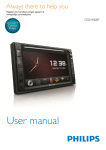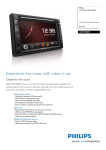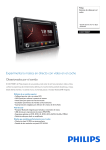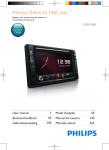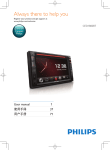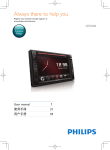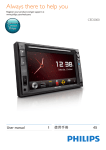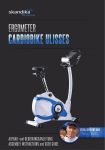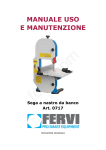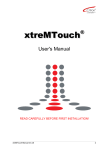Download Philips CED1900BT
Transcript
Always there to help you Register your product and get support at www.philips.com/welcome CED1900BT Question? Contact Philips User manual 3 Manuale utente 77 Gebruiksaanwijzing 25 Gebruiksaanwijzing 103 Moded’emploi 51 Instrukcjaobsługi 129 Contents 1Safety 2 Your car entertainment system Introduction What's in the box 3 Install the car entertainment system Connect wires Mount into the dashboard 4 Get started Prepare the remote control Turn on Use the home menu Set the date and time 5 Play from hard media Load a disc Connect a USB storage device Insert an SD/SDHC card Control play Browse recorded files 6 Listen to radio Switch to radio mode Set up Tune to a radio station Store radio stations in memory Tune to a preset radio station 7 Use the navigation system Insert the map data card Navigate your road trip 8 Use Bluetooth devices Activate the Bluetooth function Pair a device Play audio from a connected device Make a call 2 2 2 3 9 Play from an iPod/iPhone Connect your iPod/iPhone Control play Charge your iPod/iPhone 3 3 7 10 Adjust sound 8 8 8 9 9 11Others 10 10 10 10 11 12 12 12 12 13 13 13 17 17 17 18 18 Compatible iPod/iPhone models 18 18 18 Adjust the volume level Mute sound 18 18 19 19 20 20 Play external audio/video input Use rear monitors Use buttons on the steering wheel Set the rear view camera Reset the system 12 Product information 20 13Troubleshooting 22 22 22 General About the Bluetooth device 14Notice 23 23 23 23 24 Compliance Care of the environment Trademark notice Copyright 14 14 14 14 14 14 16 16 EN 1 English Contents 1Safety • Risk of swallowing coin battery! • battery, which can potentially be swallowed. Keep Read and understand all instructions before you use the device. If damage is caused by failure to follow instructions, the warranty does not apply. • the battery out of reach of children at all times! If swallowed, the battery can cause serious injury or Use of controls or adjustments or performance of death. Severe internal burns can occur within two procedures other than herein may result in hazardous hours of ingestion. radiation exposure or other unsafe operation. • • The device is designed for negative ground (earth) 12 V immediate medical attention. To reduce the risk of traffic accidents, do not watch • video when driving. • Make sure that the battery compartment is completely secure after you replace the battery. Improper fuses can cause damage or fire. When you • need to change the fuse, consult a professional. • If the battery compartment cannot be completely secured, discontinue use of the product. Keep out Use only the supplied mounting hardware for a safe of reach of children and contact the manufacturer. and secure installation. • When you change the batteries, always keep all new and used batteries out of reach of children. To ensure safe driving, adjust the volume to a safe and comfortable level. • If you suspect that a battery has been swallowed or placed inside any part of the body, seek DC operation only. • The device may contain a coin/button type To avoid short circuits, do not expose the device, remote control or remote control batteries to rain or water. • The device shall not be exposed to dripping or 2 splashing. • Do not place any sources of danger on the device (e.g. liquid filled objects, lighted candles). • Never insert objects into the ventilation slots or other openings on the device. • Never place any objects other than discs into the disc tray/slot. • To avoid exposure to laser radiation, do not disassemble the device. • Risk of damage to the screen! Never push, rub, or strike the screen with any object. • Never use solvents such as benzene, thinner, cleaners available commercially, or anti-static sprays intended for discs. • Clean the device with soft, damp cloth. Never use substances such as alcohol, chemicals or household cleaners on the device. 2 EN Your car entertainment system Congratulations on your purchase, and welcome to Philips! To fully benefit from the support that Philips offers, register your product at www.philips.com/welcome. Introduction With the car entertainment system, you can • • • • • • listen to music, watch videos, view pictures, listen to FM (RDS included) and AM/MW radio, make phone calls via Bluetooth, and navigate your road trip. What's in the box •• This system is designed for negative ground (earth) 12V Check and identify the contents of the package: a b c d e f g h DC operation only. •• Always install this system in the car dashboard. Other 1 Main unit (with a sleeve) 2 Remote control 3 Trim plate 4 Rubber cushion 5 Screw X 4 (M5x8mm) 6 Hexagon head screw 7 Remote control battery 8 User manual locations can be dangerous as the rear of the system heats up during use. •• To avoid short-circuit: before you connect, make sure that the ignition is off. •• Make sure that you connect the yellow and red power supply leads after all other leads are connected. •• Make sure that all loose leads are insulated with electrical tape. •• Make sure that the leads do not get caught under screws iron parts that will move (e.g. seat rail). •• Make sure that all ground (earth) leads are run to a common ground (earth) point. •• Use only the supplied mounting hardware for a safe and secure installation. •• Improper fuses can cause damage or fire. When you need to change the fuse, consult a professional. •• When you connect other devices to this system, make sure that the rating of the car circuit is higher than the total fuse value of all the connected devices. •• Never connect speaker wires to the metal body or chassis of the car. •• Never connect speaker wires with stripes to one another. Connect wires Note •• The ISO male connectors are not supplied. •• Make sure that all loose leads are insulated with electrical tape. 3 Install the car entertainment system •• Consult a professional to connect wires as instructed below. •• Before connection, check the car's wiring carefully. 1 Connect the ISO male connectors. Always follow the instructions in this chapter in sequence. These instructions are for a typical installation. However, if your car has different requirements, make the adjustment accordingly. If you have any question regarding installation kits, consult your local retailer. EN 3 English Note ISO male connectors Connect to Connectors and sockets on rear panel External sockets or connectors Green strip, black-edged green strip Rear left speaker 1 For ISO male connectors As indicated above 2 REAR OUT L (White socket) b White strip, black-edged white strip Front left speaker Rear left speaker c Gray strip, black-edged gray strip Front right speaker 3 REAR OUT R (Red socket) Rear right speaker 4 Front right speaker Rear right speaker FRONT OUT R (Red socket) d Purple strip, black-edged purple strip 5 Front left speaker Red strip Ignition key +12V DC when ON/ACC FRONT OUT L (White socket) e 6 f Blue strip Motor/electric antenna relay control lead VIDEO OUT 1 (Yellow socket) Video input socket of an external display device g White-edged blue strip Amplifier relay control lead 7 VIDEO OUT 2 (Yellow socket) Video input socket of an external display device Video output socket of an external player a h Black strip Ground 8 VIDEO IN (Yellow socket) i Yellow strip The +12V car battery which is energized at all times 9 CAMERA IN (Purple socket) Video output socket of an external camera 10 SUB-W OUT (Blue socket) Sub-woofer 11 AV-IN L (White socket) Left audio channel output socket of an external player 12 AV-IN R (Red socket) Right audio channel output socket of an external player 13 REVERSE CAMERA (Purple wire) Reverse camera (B+) 14 PARKING BRAKE (Pink wire) Parking brake (-) 15 OE SWC IR REMOTE IN (Brown wire) OE SWC remote in 16 OE SWC IR REMOTE IN (Black wire) Ground 17 OE SWC AD LEARN (White wire) OE SWC AD Learn line 1 18 OE SWC AD LEARN (White wire) OE SWC AD Learn line 2 19 OE SWC AD LEARN (Black wire) Ground 20 External Mic (Black connector) External microphone 21 EXTERNAL BOX CONNECTOR (Black connector) External navigation box 22 GPS AERIAL (Black connector) GPS smart antenna 23 RADIO ANTENNA (Black connector) Radio antenna 2 Connect other wires if necessary. Caution •• To avoid an accident, the driver must not watch video while driving. By design, this system disallows watching video during drive. Park your car in a safe place and engage the parking brake before watching video. Note •• When the parking brake of your vehicle is not engaged, the video blocking system is activated. It blocks the display of front video source only. •• If the system is not properly connected with the parking brake control module of your vehicle, video signals will be blocked by the system, with the below message displayed on the TFT. 4 EN External sockets or connectors 24 Rear Monitor Audio Out 1 (White connector) Left audio channel input socket of one rear monitor 25 Rear Monitor Audio Out 1 (Red connector) Right audio channel input socket of one rear monitor 26 Rear Monitor Audio Out 2 (White connector) Left audio channel input socket of another rear monitor 27 Rear Monitor Audio Out 2 (Red connector) Right audio channel input socket of another rear monitor English Connectors and sockets on rear panel Tip •• The pin arrangement for the ISO connectors depends on the type of your vehicle. To avoid damage to the system, connect properly. EN 5 s r z q y p x o w v n u m t a b 6 EN c d e f g h i j k l 3 Remove the mounting sleeve with the supplied disassembly tools. English Mount into the dashboard Note •• Make sure that wires are correctly connected before you mount the main unit into a car. •• If preset radio stations are lost when the ignition key is turned OFF and then back ON, reconnect the red leads crosswise to the yellow ones. 1 If the car does not have an on-board drive or navigation computer, disconnect the negative terminal of the car battery. • 4 Install the sleeve into the dashboard and bend the tabs outward to fix the sleeve. • If you disconnect the car battery in a car that has If the system is not fixed by sleeve but by the supplied screws, skip this step. an on-board drive or navigation computer, the computer may lose its memory. • If the car battery is not disconnected, to avoid short-circuit, make sure that bare wires do not touch each other. Make sure that the car dashboard opening is within these measurements: 5 m 5m 182 • Slide the unit into the dashboard until a click sound is heard. mm 112 mm 2 6 Attach the trim plate. 7 Reconnect the negative terminal of the car battery. Since the unit cannot be used if the dashboard opening's slant angle is above 20 degrees, make sure that the horizontal slant of the car dashboard opening is between 0 and 20 degrees. EN 7 4 Get started Caution Turn on Press . »» PHILIPS logo and a progress bar are displayed while boot-up. •• Risk of car accidents! Never watch video or operate this system while driving. • To turn off the system, press and hold for 3 seconds. Prepare the remote control For the first time use For the fist time use After successful boot-up, the following interface is displayed. Pull the protective sheet out. »» The remote control is ready for use. Replace the battery Caution •• Risk of explosion! Keep batteries away from heat, sunshine or fire. Never discard batteries in fire. 1 Tap to select a language for on-screen display. »» The following interface is displayed. Note •• Remove the battery if it is exhausted or if the remote control is not to be used for a long time. •• Batteries contain chemical substances, they should be disposed of properly. •• Perchlorate Material - special handling may apply. See www.dtsc.ca.gov/hazardouswaste/perchlorate. 2 Tap to select a radio region that matches your location. »» The following interface is displayed. 3 Tap [Finish] to complete the initial setup. »» The device switches to radio mode automatically. 1 2 3 8 Pull out the battery tray. Insert one CR2025 battery with correct polarity (+/-) as indicated. Insert the battery tray. EN • Use the home menu English external video player. Note • is displayed when you touch an icon, it indicates that the selected media or feature is unavailable at the current time. • [Rear zone]: Access the settings for rear [SWC]: Access the interface to assign functions to buttons on the steering wheel. • Access the home menu R monitors. •• If Tap [AV-IN 1]/[AV-IN 2]: Switch the source to the audio and video input that is transferred from an [Settings]: Access the system menu. Set the date and time to access the home menu. »» The clock, date, and the bar for popular icons are displayed. 1 2 Tap > to access the full menu with all feature icons displayed. Tap [Settings]. »» The [General]menu is displayed. • To access the full menu with all feature icons displayed, tap • . To return to the home menu, tap . 3 4 • • • • • [24Hr]: 24-hour time format [12Hr]: 12-hour time format Tap [Date] to display the interface for setting the date. [Radio]: Switch the source to FM/AM radio. [Disc]: Switch the source to disc. [USB]: Switch the source to USB storage device. • Tap [Clock Mode] to select a time format. 5 6 Tap 7 8 Tap to set the year, month, and date. Tap [Time] to display the interface for setting the time. [SDHC]: Switch the source to SD/SDHC card. • : Once your iPod/iPhone is connected and recognized, this icon is displayed in the bar of favorite icons. Tap it to switch the source back to iPod/iPhone. • • [Navigation]: Access the navigation system. [Bluetooth]: Use the Bluetooth feature. Tap to set the hour and minute. to return to the home menu. EN 9 5 Play from hard media You can use this system to listen to audio, watch videos, and view photos that are stored on a disc, USB storage device, or SD/SDHC card. Connect a USB storage device Note •• Make sure that the USB storage device contains compatible files. •• NTFS (New Technology File System) file system is not Note supported. •• Before use, check for compatible media. 1 2 Load a disc Push the USB socket cover upwards to open it. Connect the USB storage device to the USB socket. »» Play starts automatically. Caution •• Never insert any object other than a disc of 12-cm diameter into the disc slot. • To remove the USB storage device, switch the system to another source first. 1 Insert the disc into the disc slot with the label side facing up. »» Play starts automatically. • If play does not start automatically, tap the screen to display the 2 icon, and then tap to start play. To eject the disc, press . »» When the disc is ejected, the system switches to the previous source or radio mode. Insert an SD/SDHC card Note •• Make sure that the SD/SDHC card contains compatible files. •• NTFS (New Technology File System) file system is not supported. 1 2 Flip up the protective cover. Insert the SD/SDHC card into the hear a "click". slot until you »» Play starts automatically. Region Code You can play DVD discs marked with the following region code. DVD region code Countries Europe Remove the SD/SDHC card 1 2 3 10 EN Switch system to another source. Press the card inwards until you hear a "click". »» The card is disengaged. Pull out the SD/SDHC card. [16:9]/[4:3]: Select an aspect ratio. : Tap to display the brightness bar, and then tap on English • • Control play the bar to adjust the screen brightness. Videos • : Tap to display the contrast bar, and then tap on the bar to adjust the image contrast. • : Tap to display the saturation bar, and then tap on the bar to adjust the image saturation. • : Display control icons on the first page. Audios • • • • • : Return to the home menu. : Zoom in or out of the image. : Select an available audio channel or audio language. : Select an available subtitle. • • For DVD, return to the disc menu or root menu. For recorded files, return to the list of files or folders. • • • • • • PBC: For VCD/SVCD only, enable or disable the PBC (Playback Control) feature. • / : Skip to the previous or next title, chapter, track, or file. • To search forward fast or rewind the track, tap on the progress bar. • • / : Start, pause, or resume play. : Display control icons on the second page. : Return to the home menu. Press once to access the track list. Press twice to access the folder list. Press repeatedly to return to the playback interface. • : For recorded files only, skip to the next audio folder. • • : Return to the list of tracks or folders. / • : Skip to the previous or next track. To search forward fast or rewind the track, tap on the progress bar. • • / • • • : Start, pause, or resume play. / / : Select a repeat mode. : Repeat the current track. : For recorded files, repeat all tracks in the current folder. • : Select a repeat mode. DVD: [Repeat chapter] (repeat the current chapter), [Repeat title] (repeat the current title), [Repeat all] (repeat all chapters and titles), or • • (highlighted): Repeat all tracks. : Select random play ( sequential play ( highlighted) or in gray). [Repeat off] (cancel repeat play). • VCD/SVCD: [Repeat one] (repeat the current track) or [Repeat all] (repeat all tracks). • Recorded files: [Repeat one] (repeat the current video file), [Repeat folder] (repeat all video files in the current folder), or [Repeat all] (repeat all video files). EN 11 2 Pictures 3 • • • : Return to the home menu. : Zoom in or out of the picture. / : Rotate the picture clockwise or anti-clockwise by 90 degrees. • • • • • • / / / : Return to the list of files or folders. : Select the previous or next picture. : Pause or resume the slideshow. : Tap to display the brightness bar, and then tap on the bar to adjust the screen brightness. • : Tap to display the contrast bar, and then tap on • • • : Display the list of audio tracks or folders. : Display the list of picture files or folders. : Display the list of video files or folders. Tap the name of a file to start play. 6 Listen to radio Switch to radio mode After the boot-up at the first time, the system switches to radio mode automatically. To switch the source back to radio afterwards, tap [Radio] on the home menu. »» The interface for radio is displayed. : Display control icons on the second page. [16:9]/[4:3]: Select an aspect ratio. Tap an icon to select a file category. Set up Before you search for radio stations, make prior setup. Tap to display the setup menus. the bar to adjust the image contrast. • : Tap to display the saturation bar, and tap on the bar to adjust the image saturation. • : Display control icons on the first page. Browse recorded files During playing recorded files, you can access the file list and select files from the list. 1 12 Tap EN to access the list of files or folders. Select a radio range 1 Tap [Radio Range]. Tap [Distance] or [Local] to select a tuner sensitivity. • • [Distance]: Stations with strong and weak signals Store radio stations in memory can be tuned to. You can store up to 6 stations in each band. [Local]: Only stations with strong signals can be tuned to. Enable the RDS feature Note Store radio stations manually 1 2 3 •• RDS feature is enabled by default. •• Only after the RDS feature is enabled, the option of Select a band. Tune to the target radio station. Tap and hold one of the channels (1 to 6) over two seconds. »» The radio station is saved under the selected channel. [PTY list] is displayed. Tap [RDS Off] (RDS disabled) to enable the RDS feature. »» The option of [PTY list]is displayed. • To disable the RDS feature, tap [RDS On] (RDS enabled). Tune to a radio station English 2 Store radio stations automatically You can search for a radio station with intro search, which broadcasts a 10-second preview of each detected radio station. 1 2 3 Select a band. Tap . Tap [Auto Store]. »» Auto search starts. The six strongest stations of the selected band are saved in preset channels automatically. Tune to a preset radio station 1 2 Tap FM or AM to select a band. • • FM bands: FM1, FM2, FM3 AM bands: AM1, AM2 1 2 Select a band. Tap one of the preset channels (1 to 6) to select a preset radio station. Tap or repeatedly until the frequency of target radio station is displayed. • To tune to a radio station automatically, tap and hold or until the frequency digits start change. Tip •• You can also press BAND on the remote control repeatedly to select a band. EN 13 7 Use the navigation system Insert the map data card Note •• The map data card is not included in the packaging. •• Before using the map data card, update the map data 8 Use Bluetooth devices With this system, you can listen to audio from a player and make a call through Bluetooth. Activate the Bluetooth function • • On the home menu, tap In any other mode, tap . on top of the screen. if necessary. Pair a device Note •• Philips does not guarantee the compatibility with all Bluetooth devices. •• Before pairing a device with this system, read its user manual for Bluetooth compatibility. 1 2 3 •• Make sure that Bluetooth function is enabled on your Flip up the protective cover. Insert the map data card into the MAP slot until you hear a "click". Close the protective cover. Navigate your road trip Note •• Risk of traffic accident! Never operate the navigation system during drive. Complete the setting of your destination and other navigation specifications before you drive. 1 device, and your device is set as visible to all other Bluetooth devices. •• The operational range between this system and a Bluetooth device is approximately 8 meters (24 feet). •• Any obstacle between this system and a Bluetooth device can reduce the operational range. •• Keep away from any other electronic device that may cause interference. Pair the first device 1 Activate the Bluetooth function on this system. »» The following interface is displayed. Press NAVI. • You can also tap on the home menu to access the navigation system. »» The navigation interface is displayed in a few 2 14 seconds. Follow the user manual of the navigation map to set navigation specifications. EN 2 Tap on this system to search for other Bluetooth devices. In the device list, tap the name of your Bluetooth behind the name. device, and then tap : Tap it to display the list of paired players. : Tap it to display the on-screen keypad for English 3 phone calls. : Tap it to display the phone book that is synchronized with your mobile phone and keypad. : Tap it to display the list of favorite contacts. Pair more devices »» The paring starts, and then a pairing request from 4 1 Activate the Bluetooth function on this system. »» One of the following interfaces is displayed. CED1900 is displayed on your device. On your device, accept the pairing request from CED1900, enter the default password '0000', and then confirm the password entry. »» [Paired OK!] flashes, and then [Connecting] is 5 displayed on this system. On your device, enable or permit the connection with CED1900. • If a player is connected, the music playback interface is displayed on this system. 2 Tap 3 4 Tap [New Pairing] to start searching for Bluetooth devices. on the top right corner. : Tap it to return to the music playback interface. : Tap it to display the list of paired mobile phones. : Tap it to display the list of paired mobile phones. : Tap it to display the list of paired mobile phones. • If a mobile phone is connected, the keypad is displayed on this system. Repeat steps 3 to 5 that are indicated in the above section "Pair the first device" to complete the connection. Note •• You can connect a music player and a mobile phone simultaneously. EN 15 Manage paired devices 1 2 3 1 2 Play a track on the connected device. 3 Tap icons on the interface to control play. Activate the Bluetooth function. Tap • • or to display the music playback . To manage paired players, tap . To manage paired mobile phones, tap Tap On this system, tap interface. . on the top right corner. • • : Pause or resume play. / : Select the previous or next track. 4 Note Tap [Paired Device]. »» The list of paired devices is displayed. •• If the connected device does not support the AVRCP profile, control play on the connected device. Make a call Note 5 Tap the name of the paired device that you want to reconnect, disconnect, or delete. • • • 6 : Tap to reconnect the device. : Tap to disconnect the device. : Tap to delete the device from the list of paired devices. Tap , , or •• Keep the Bluetooth connection active between the system and your mobile phone. Call a number You can make phone calls with the system. 1 Tap on top of the screen. »» The keypad is displayed. . • Tip If the keypad is not displayed, tap . •• If you want to manually reconnect a device after the connection is interrupted, disable the function of automatic connection. Play audio from a connected device If the connected Bluetooth device supports Advanced Audio Distribution Profile (A2DP), you can listen to tracks that are stored on the device through the system. If the device also supports Audio Video Remote Control Profile (AVRCP) profile, you can control play on the system or with its remote control. 16 EN 2 Tap number icons to enter the phone number. • • • To clear the last digit, tap To clear all digits, tap . . To return to the previous screen, tap . Tap • • 9 to send the call. To end the call, tap . To enter numbers during the call, tap to display the keypad first. Note Redial the last called number 1 2 Tap •• During play, no audio signals are transferred through the headphone socket of your iPod/iPhone. . »» The last called number is displayed. Tap Compatible iPod/iPhone models again to send the call. This system supports the following iPod and iPhone models. Answer a call Note •• By default, all incoming calls are picked up automatically. You can disable the function of automatic answer. 1 2 Play from an iPod/ iPhone English 3 When there is an incoming call, [Incoming call…] is displayed on the screen. Tap • iPhone 4, iPhone 3GS, iPhone 3G, and iPhone iPod touch (1st, 2nd, 3rd, and 4th generations) iPod nano (1st, 2nd, 3rd, 4th, 5th, and 6th generations) iPod classic Connect your iPod/iPhone Connect an Apple 30-pin USB cable to: to answer the call. To reject or end the call, tap • • • • . • • the USB socket on the front panel of this system, and your iPod/iPhone. »» The system starts playing tracks that are stored on Transfer a phone call to mobile phone your iPod/iPhone. By default, the voice comes from the loudspeakers during a call. • 1 is displayed in the bar of popular icons on the Tap to transfer the phone call to your mobile phone. »» The loudspeakers are muted, and the voice comes 2 Once your iPod/iPhone is connected and recognized, from the mobile phone only. Take up your mobile phone for the conversation. home menu. You can tap it to switch back to this playback interface. Note •• Before you disconnect your iPod/iPhone, switch the system to another source. EN 17 10 Adjust sound Control play By default, use the on-screen playback interface of this system to control play. When you listen to radio, enjoy music, or watch video, follow the instructions below to adjust sound. • • • Adjust the volume level : Tap to pause play. : Tap to resume play. / : Tap to play the previous or next track. • / • • • • : Tap to select a repeat mode. • (highlighted): Repeat all tracks. (in gray): Cancel repeat play. (highlighted): Play tracks randomly. +: Increase the volume level. -: Decrease the volume level. Mute sound Press • : Tap to switch to the iPod control mode, and then on the front panel. To release the speakers from mute status, press again. (in gray): Play tracks in sequence. you can control play on your iPod/iPhone. • • • : Repeat the current track. : Tap to select a play mode. • • Press +/- repeatedly on the front panel. 11Others : Tap to switch back to the on-screen control mode, and then you can control play on this system. • : Tap to access the music menu. Search for a track Play external audio/video input You can connect an external audio/video player to this system. You can select a track quickly through the music menu. 1 Tap to access the music menu. 1 2 3 Tap to select a category. »» Tracks under the selected category are listed. Tap a track name to start play. • If one or more subcategories are under the selected category, select a category first. Charge your iPod/iPhone Once the iPod/iPhone is connected and recognized, the iPod/ iPhone begins to charge. 2 3 4 Connect a composite AV cable to • • the AV-IN socket on the front panel, and the audio and video output sockets of the external player. Tap > to access the full menu with all feature icons displayed. Tap [AV-IN 1] to display the playback interface. Operate on the external player to start play (see the user manual of the external device). Tip •• If you connect this system to an external player through the VIDEO IN, AV-IN L, and AV-IN R sockets on the rear panel, tap instead of 18 EN [AV-IN 2] to switch the source [AV-IN 1]. 4 5 If one or two monitors are connected for backseat passengers, you can select different sources for front and backseat passengers. Tap to select an available source to start play. Tap [Rear speaker] to enable or disable the audio output to rear speakers. • • English Use rear monitors [On]: Enable the audio output to rear speakers. [Off]: Mute rear speakers. Note •• Make sure that rear monitors are correctly connected to this system. •• Only when the multi-zone display mode is activated, rear monitors can receive signals from the system. •• By default, the same signals are transferred to the front and rear monitors. •• When a disc, USB storage device, SD/SDHC card, or iPod/iPhone connected through the USB socket is selected as the source for front zone, you cannot select another source for rear zone. •• Only when the system is in radio mode, navigation mode, or Bluetooth mode, you can select a source for rear zone from disc, SD/SDHC card, USB storage device, or iPod/ iPhone connected through the USB socket. 1 2 6 R to return to the previous mode. Switch the control interfaces When different sources are selected for front passengers and backseat passengers, you can tap R to switch the control interface for front source or rear source. »» When Tap > to access the full menu with all feature icons displayed. Tap Tap R is solidly displayed, the current control interface is for the front source. »» When . R blinks with and [Rear zone] displayed, the current control interface is for the »» The [Rear zone] menu is displayed. rear source. Use buttons on the steering wheel You can assign a function to a button on the steering wheel, and then control the system with that button. 3 Tap [Mode] to enable or disable the signal transferring to rear monitors. • • [On]: Enable the signal transferring to rear monitors. 1 2 Tap > to access the full menu with all feature icons displayed. Tap . »» The [Steering Wheel Remote Control Learning] interface is displayed. [Off]: Disable the signal transferring to rear monitors. »» When it is enabled, the following interface is displayed. EN 19 3 Tap an icon, for example, , of which you want to assign the function to a button on the steering wheel. Reset the system If the system hangs up, reset it. 4 • To cancel the assignment, tap [Cancel]. Press and hold the button on the steering wheel for one second. 1 2 Flip up the protective cover. Press RESET with the tip of a ball-point pen or toothpick. »» The following interface is displayed. 12 Product information Note •• Product information is subject to change without prior 5 Repeat steps 3 and 4 to assign more functions to buttons on the steering wheel. • To clear the assignment, tap [Clear all]. Set the rear view camera If a rear view camera is connected, you can view on the screen what the camera takes. 1 2 Tap > to access the full menu with all feature icons displayed. Tap (the icon is displayed only when a compatible camera is correctly connected). »» Picture from rear camera is displayed. notice. General Power supply 12 V DC (11 V - 16 V), negative ground Fuse 15 A Suitable speaker impedance 4-8 Maximum power output 45 W x 4 channels Continuous power output EN 10% Pre-Amp output voltage 4.0 V (CD play mode; 1 kHz, 0 load) dB, 10 k Sub-woofer output voltage 4.0 V (CD play mode, 61 Hz, 0 load) dB, 10 k Aux-in level 20 24 W x 4 channels (4 T.H.D.) 800 mV Dimensions (W x H x D) 178 x 101.5 x 160 mm Weight (main unit) 3.1 kg USB playability information System DVD / CD audio / MP3 system Disc diameter 12 cm Frequency response 20 Hz - 20 kHz Signal/noise ratio > 75 dB Total harmonic distortion Less than 0.3% • • • • Channel separation > 55 dB Supported USB formats: Video signal format NTSC/PAL Video output 1 +/- 0.2 V p-p • • • • • • • • Radio Frequency range - FM 87.5 - 108.0 MHz (50 kHz per step) Frequency range - AM(MW) 522 - 1620 kHz (9 kHz per step) Usable sensitivity - FM 2 uV Usable sensitivity - AM (MW) 25 uV LCD USB flash memory (USB 2.0 or USB1.1) USB flash players (USB 2.0 or USB1.1) Memory cards (SD/SDHC) Maximum capacity: 32 G USB or memory file format: FAT16, FAT32 MP3 bit rate (data rate): 32-320 Kbps and variable bit rate WMA v9 or earlier Directory nesting up to a maximum of 8 levels Number of albums/folders: maximum 99 Number of tracks/titles: maximum 999 ID3 tag v2.0 or later File name in Unicode UTF8 (maximum length: 128 bytes) Supported MP3 disc format: • • ISO9660, Joliet Maximum title number: 512 (depending on file name length) Screen size 6.2 inches Display resolution 800 x 480 dots Contrast ratio 500 Brightness 450 cd/m² • • • Communication system Bluetooth Standard version 2.0 Output Bluetooth Standard Power Class 2 Maximum communication range Line of sight approx. 8m Frequency band 2.4 GHz band (2.4000 GHz - 2.4835 GHz) Compatible Bluetooth profiles Hands-Free Profile (HFP) Handset Profile (HSP) Advanced Audio Distribution Profile (A2DP) Audio Video Remote Control Profile (AVRCP) Maximum album number: 255 Supported sampling frequencies: 32 kHz, 44.1kHz, 48 kHz Supported Bit-rates: 32-320 Kbps and variable bit rate Supported video formats: • • Bluetooth Supported codecs Receive Transmit Compatible USB devices: English Disc player DVD Divx Note •• To ensure a better playback, it is recommended that file image size is no higher than 640 x 480, frame rate is 20 fps, data rate is no higher than 500 kbps. SBC (Sub Band Codec) SBC (Sub Band Codec) EN 21 13Troubleshooting Warning •• Never remove the casing of this product. To keep the warranty valid, never try to repair the product yourself. If you encounter problems when using this product, check the following points before requesting service. If the problem remains unsolved, go to the Philips Web page (www.philips. com/support). When you contact Philips, make sure that the product is nearby and the model number and serial number are available. General No power •• Car engine has not been started. Start the car engine. •• Connections are incorrect. •• The fuse has been damaged. Replace the fuse. No sound •• Volume is too low. adjust the volume. •• Speaker connections are incorrect. No response to the remote control •• Make sure that the path between the remote control and the unit is clear from obstacles. •• Move the remote control close to the unit, and point it at the iR sensor. •• •• •• to switch to the control interface for front Press source or rear source. The function is not applicable to the current media. Replace the remote control battery. The disc does not play. •• The disc is upside down. Make sure that the printed side is upwards. •• The disc is dirty. Clean the disc with a clean, soft, lintfree cloth. Wipe the disc outwards from the center. •• The disc is defective. Try another disc. •• The disc is incompatible. Try another disc. •• The recordable disc is not finalized. •• The region code of DVD disc is not supported. Use a disc with proper region code. Cannot play DivX file from an SD/SDHC card or USB storage device •• DivX DRM protected files cannot be played if they are saved on an SD/SDHC card or USB storage device. Transfer it to a compatible disc instead. No image •• Parking wire connection is incorrect. Check the wiring. 22 EN No image on rear monitor • •• Enable the signal transferring to rear monitors. A DivX video can be played for front passengers only. Image flashes or is distorted. •• Video connection is improper. Check the connections. Noise in broadcasts •• Signals are too weak. Select another station with stronger signals. •• Check the connection of the car antenna. Preset stations are lost. •• Battery cable is not correctly connected. Connect the battery cable to the terminal that is always live. The fuse is broken. •• The fuse type is incorrect. Replace it with a 15 A fuse. •• Speaker wire or power wire is grounded. Check the connections. About the Bluetooth device Music playback is unavailable on the system even after successful Bluetooth connection. •• The device cannot be used with the system to play music. The audio quality is poor after connection with a Bluetooth-enabled device. •• The Bluetooth reception is poor. Move the device closer to the system or remove any obstacle between the device and the system. Cannot connect with the system. •• The device does not support the profiles required for the system. •• The Bluetooth function of the device is not enabled. Refer to the user manual of the device to find out how to enable the function. •• The system is not in the pairing mode. •• The system is already connected with another Bluetooth-enabled device. Disconnect that device or all other connected devices and then try again. The paired mobile phone connects and disconnects constantly. •• The Bluetooth reception is poor. Move the mobile phone closer to the system or remove any obstacle between the mobile phone and the system. •• Some mobile phones may connect and disconnect constantly when you make or end calls. This does not indicate any malfunction of the system. •• For some mobile phones, the Bluetooth connection may be deactivated automatically as a power-saving feature. This does not indicate any malfunction of the system. Any changes or modifications made to this device that are not expressly approved by Philips Consumer Lifestyle may void the user’s authority to operate the equipment. Compliance This product complies with the radio interference requirements of the European Community. This apparatus includes this label: Your product contains batteries covered by the European Directive 2006/66/EC, which cannot be disposed with normal household waste.Please inform yourself about the local rules on separate collection of batteries because correct disposal helps to prevent negative consequences for the environmental and human health. Environmental information All unnecessary packaging has been omitted. We have tried to make the packaging easy to separate into three materials: cardboard (box), polystyrene foam (buffer) and polyethylene (bags, protective foam sheet.) Your system consists of materials which can be recycled and reused if disassembled by a specialized company. Please observe the local regulations regarding the disposal of packaging materials, exhausted batteries and old equipment. Trademark notice The Bluetooth® word mark and logos are registered trademarks owned by Bluetooth SIG, Inc. and any use of such marks by Philips is under license. Care of the environment Windows Media and the Windows logo are trademarks, or registered trademarks of Microsoft Corporation in the United States and/or other countries. Your product is designed and manufactured with high quality materials and components, which can be recycled and reused. When this crossed-out wheeled bin symbol is attached to a product it means that the product is covered by the European Directive 2002/96/EC. Please inform yourself about the local separate collection system for electrical and electronic products. Please act according to your local rules and do not dispose of your old products with your normal household waste. Correct disposal of your old product helps to prevent potential negative consequences for the environment and human health. “Made for iPod” and “Made for iPhone” mean that an electronic accessory has been designed to connect specifically to iPod or iPhone respectively, and has been certified by the developer to meet Apple performance standards. Apple is not responsible for the operation of this device or its compliance with safety and regulatory standards. Please note that the use of this accessory with iPod or iPhone may affect wireless performance. iPod and iPhone are trademarks of Apple Inc., registered in the U.S. and other countries. DivX®, DivX Certified® and associated logos are trademarks of Rovi Corporation or its subsidiaries and are used under license. ABOUT DIVX VIDEO: DivX® is a digital video format created by DivX, LLC, a subsidiary of Rovi Corporation. This is an official DivX Certified® device that plays DivX video. Visit EN 23 English 14Notice divx.com for more information and software tools to convert your files into DivX videos. ABOUT DIVX VIDEO-ON-DEMAND: This DivX Certified® device must be registered in order to play purchased DivX Video-on-Demand (VOD) movies. To obtain your registration code, locate the DivX VOD section in your device setup menu. Go to vod.divx.com for more information on how to complete your registration. Manufactured under license from Dolby Laboratories. Dolby and the double-D symbol are trademarks of Dolby Laboratories. 'DVD Video' is a trademark of DVD Format/Logo Licensing Corporation. Other trademarks and trade names are those of their respective owners. Copyright 2012 © Koninklijke Philips Electronics N.V. Specifications are subject to change without notice. Trademarks are the property of Koninklijke Philips Electronics N.V or their respective owners. Philips reserves the right to change products at any time without being obliged to adjust earlier supplies accordingly. This item incorporates copy protection technology that is protected by U.S. patents and other intellectual property rights of Rovi Corporation. Reverse engineering and disassembly are prohibited. 24 EN Specifications are subject to change without notice © 2012 Koninklijke Philips Electronics N.V. All rights reserved. CED1900BT_12_UM_V2.1


























